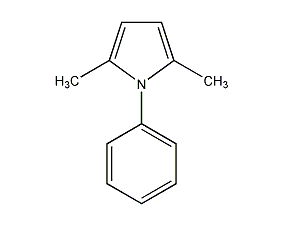
Structural formula
| Business number | 01TG |
|---|---|
| Molecular formula | C12H13N |
| Molecular weight | 171.24 |
| label |
1-phenyl-2,5-dimethylpyrrole, 2,5-Dimethyl-1-phenyl-1H-pyrrole, 1-Phenyl-2,5-dimethylpyrrole |
Numbering system
CAS number:83-24-9
MDL number:MFCD00022464
EINECS number:201-461-2
RTECS number:None
BRN number:124370
PubChem ID:None
Physical property data
1. Physical property data
1. Character: Uncertain
2. Density (g/mL,25/4℃): Unsure
3. Relative vapor density (g/ mL,air=1 ): Unsure
4. Melting point (ºC):50-51
5. Boiling point (ºC,Normal pressure):155-160
6. Boiling point (ºC,5.2kPa): Unsure
7. Refractive index: Uncertain
8. Flash Point (ºC): Unsure
9. Specific optical rotation (º): Unsure
10. Autoignition point or ignition temperature (ºC): Unsure
11. Vapor pressure (kPa,25ºC): Unsure
12. Saturation vapor pressure (kPa,60ºC): Unsure
13. Heat of combustion (KJ/mol): Unsure
14. Critical temperature (ºC): Unsure
15. Critical pressure (KPa): Unsure
16. Oil and water (octanol/Log value of the partition coefficient (water): Uncertain
17. Explosion limit ( %,V/V): Unsure
18. Lower explosion limit (%,V/V): Unsure
19. Solubility: Uncertain.
Toxicological data
None
Ecological data
None
Molecular structure data
5. Molecular property data:
1. Molar refractive index: 56.33
2. Molar volume (m3/mol):177.7
3. Isotonic specific volume (90.2K ): 427.1
4. Surface Tension (dyne/cm):33.3
5. Polarizability(10-24cm3):22.33
Compute chemical data
1. Reference value for hydrophobic parameter calculation (XlogP): 3.1
2. Number of hydrogen bond donors: 0
3. Number of hydrogen bond acceptors: 0
4. Number of rotatable chemical bonds: 1
5. Number of tautomers: none
6. Topological molecule polar surface area 4.9
7. Number of heavy atoms: 13
8. Surface charge: 0
9. Complexity: 151
10. Number of isotope atoms: 0
11. Determine the number of atomic stereocenters: 0
12. Uncertain number of atomic stereocenters: 0
13. Determine the number of chemical bond stereocenters: 0
14. Number of uncertain chemical bond stereocenters: 0
15. Number of covalent bond units: 1
Properties and stability
None
Storage method
None
Synthesis method
None
Purpose
None
extended-reading:https://www.bdmaee.net/wp-content/uploads/2022/08/Butyl-tin-triisooctoate-CAS23850-94-4-Butyltin-Tris.pdfextended-reading:https://www.newtopchem.com/archives/668extended-reading:https://www.bdmaee.net/wp-content/uploads/2022/08/Efficient-trimerization-catalyst-for-aliphatic-and-alicyclic-isocyanates.pdfextended-reading:https://www.bdmaee.net/dibutyl-tin-bis-1-thioglycerol/extended-reading:https://www.newtopchem.com/archives/44794extended-reading:https://www.bdmaee.net/dioctyl-tin-oxide-cas870-08-6-fascat-8201-catalyst/extended-reading:https://www.bdmaee.net/wp-content/uploads/2022/08/Dibutyltin-monooctyl-maleate-CAS25168-21-2-BT-58C.pdfextended-reading:https://www.newtopchem.com/archives/1875extended-reading:https://www.newtopchem.com/archives/814extended-reading:https://www.bdmaee.net/teda-catalyst-triethylene-diamine-tosoh/


Comments